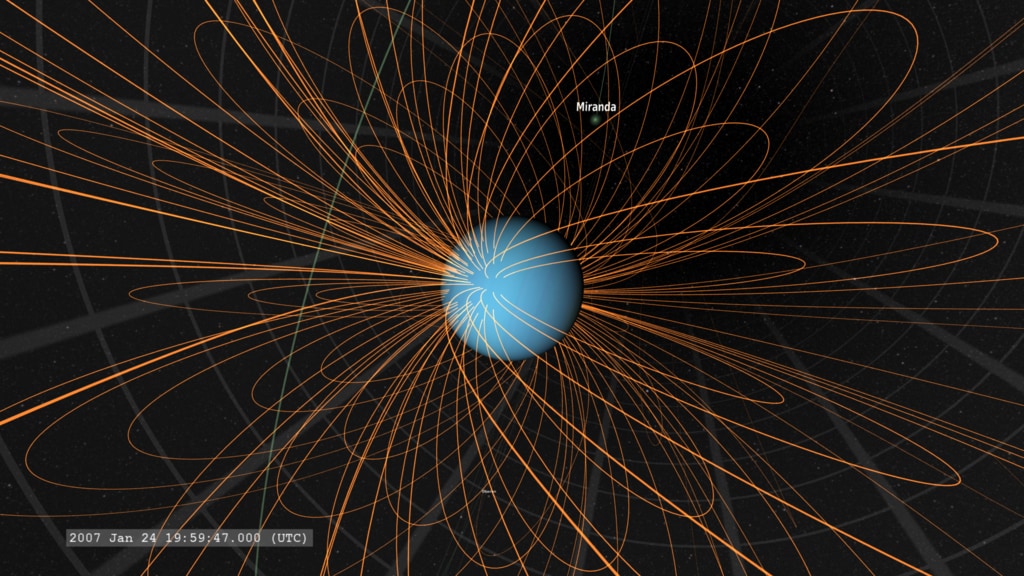A magnetosphere is the region around a body where its magnetic field controls the motion of charged particles, forming a comet‑shaped cavity in the surrounding plasma that moderates the impact of the Solar Wind and cosmic radiation. Around Earth, the dayside boundary typically stands 6–10 Earth radii from the center and the nightside stretches into a long magnetotail that can extend hundreds of Earth radii, well beyond the Moon’s orbit at 60 Earth radii, according to NASA’s heliophysics overview and image resources. NASA Heliophysics;
NASA.
Structure and boundaries
- –Bow shock: On the Sun‑facing side, the supersonic solar wind is decelerated and heated at a shock front typically located about 100,000 km upstream of Earth. ESA’s Cluster mission measured the bow shock’s motion, revealing a dynamic surface that “surfs” with solar‑wind buffeting.
ESA – Cluster.
- –Magnetosheath: Between the bow shock and the magnetopause lies a turbulent layer of shocked solar‑wind plasma where fields and flows fluctuate strongly. ESA characterizes this region as one of near‑Earth space’s most turbulent laboratories.
ESA – Cluster.
- –Magnetopause: The outer boundary where the pressure of the solar wind balances the planetary magnetic and plasma pressure; on Earth’s dayside it averages near 10 Earth radii. Britannica and NASA educational glossaries define the magnetopause as the interface separating solar‑wind–attached plasma from magnetospheric plasma.
Britannica;
NASA GSFC Glossary.
- –Cusps and magnetotail: High‑latitude cusps provide near‑direct access for solar‑wind plasma, while the nightside magnetotail consists of two low‑density lobes separated by a denser plasma sheet that stores and releases energy.
Britannica;
NASA GSFC Glossary.
Dynamics and energy transfer
- –Magnetic reconnection: When planetary and interplanetary magnetic fields interlink and reconfigure, energy and plasma enter the magnetosphere on the dayside and are released in the tail. The open‑magnetosphere circulation, first articulated by James Dungey in 1961, provides a physical basis for this global cycle.
Physical Review Letters (abstract);
NASA/ADS record;
AGU Space Weather commentary.
- –Observational advances: NASA’s Magnetospheric Multiscale (MMS) mission made high‑time‑resolution measurements of reconnection, including in the turbulent magnetosheath, quantifying how electrons and ions transfer energy.
NASA MMS;
NASA MMS;
MMS mission site.
- –Substorms and storms: Substorms are rapid energy‑release events rooted in the magnetotail; geomagnetic storms are larger, multi‑day disturbances driven by sustained solar‑wind forcing. NASA defines substorms as minutes‑to‑hours releases that brighten aurora, and NOAA details storm impacts and indices (Kp, Dst) used operationally.
NASA Heliopedia;
NOAA SWPC.
Inner magnetosphere and space‑weather hazards
- –Radiation belts: The Van Allen radiation belt system comprises zones of trapped energetic ions and electrons whose populations swell and recede with solar activity. NASA’s Van Allen Probes revealed dynamic structure, including transient three‑belt configurations and mechanisms of particle acceleration by plasma waves.
NASA;
NASA;
NASA.
- –Ring current and plasmasphere: The westward ring current (roughly 3–8 Earth radii) depresses the surface magnetic field during storms, while the cold, dense plasmasphere co‑rotates with Earth and erodes under disturbed conditions. NASA’s plasmasphere portal and NOAA/USGS materials summarize the roles of these populations in space‑weather effects on satellites, radio systems, and power grids.
NASA Plasmasphere;
USGS;
NOAA SWPC.
- –Field‑aligned currents: Currents that connect the magnetosphere and ionosphere (Birkeland currents) convey energy into the upper atmosphere, driving auroral electrodynamics. NASA educational resources describe their role in coupling and particle acceleration.
NASA SVS;
NOAA SWPC.
Planetary magnetospheres
- –Giant magnetospheres: Jupiter’s is the largest planetary magnetosphere, extending tens to hundreds of Jovian radii depending on solar‑wind pressure; intense auroral processes occur where magnetospheric plasma interacts with the ionosphere. Background values and scale comparisons are summarized by reference works and mission data compilations.
Britannica (Venus/Jupiter distances for context).
- –Intrinsic vs. induced: Planets with internal dynamos (e.g., Jupiter, Earth, Mercury) sustain intrinsic magnetospheres; unmagnetized bodies such as Venus and Mars form induced magnetospheres where the solar‑wind magnetic field drapes around the ionosphere, enhancing atmospheric escape. Studies with Venus Express, BepiColombo, and Mars MAVEN document these regimes.
Britannica (Venus);
Annales Geophysicae;
NASA;
NASA Science.
- –Mercury: MESSENGER showed a small but global magnetosphere with a relatively steady subsolar standoff near 1.4 Mercury radii and weak Birkeland currents compared with Earth.
GRL;
GRL;
NASA.
- –Magnetized moon: Ganymede uniquely possesses an intrinsic magnetosphere within Jupiter’s; Galileo flybys detected plasma‑wave signatures and a magnetometer‑defined cavity of several moon radii.
Nature;
NASA.
Measurement and theory
- –Missions: Multipoint and high‑cadence observations have been crucial. ESA’s Cluster mapped bow‑shock, magnetopause, and cusp dynamics in 3D; NASA’s MMS resolved electron‑scale reconnection physics; MESSENGER, MAVEN, Galileo, and the Van Allen Probes characterized planetary and inner‑magnetosphere processes.
ESA – 20 years of Cluster;
NASA MMS;
NASA – Van Allen Probes;
NASA – MESSENGER;
NASA – MAVEN.
- –Pressure balance and variability: The magnetopause distance scales approximately with the inverse sixth root of solar‑wind dynamic pressure in simplified models, but real magnetospheres deviate because of additional current systems and non‑linear energy transfer.
arXiv (review);
Britannica.
Impacts and applications
- –Space weather: Magnetospheres shield atmospheres and technologies yet also channel storm energy that can disrupt radio propagation, satellite orbits, navigation, and power systems. Operational guidance from NOAA and hazard summaries from USGS outline these effects for users of critical infrastructure.
NOAA SWPC;
USGS.
Related concepts and terms include Magnetic reconnection, Geomagnetic storm, and the current systems that couple the magnetosphere to the Ionosphere, which together govern auroral phenomena and energy transfer in near‑planet space. NASA Heliophysics;
NOAA SWPC.
